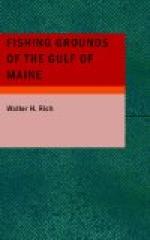Jerry Yorks Ridge. This lies just inside and paralleling Jeffreys Ledge WNW. from its shoal water and about 5 miles distant from the ledge and about 18 miles Se. by S. 1/2 S. from Cape Porpoise. This ground has from 45 to 48 fathoms of water on a rocky broken bottom. It is about 5 miles long, NNE. and SSW., and averages 1 1/2 miles wide. This is a good cod and haddock ground In the fall and up to January, these fish returning here in the spring months.
Howard Nunans Ridge. Of similar nature to the last, this rises 4 miles inside of and parallel to it, lying 14 miles from Cape Porpoise on the same bearings (Se. by S. 1/2 S.). This appears to be made up of two shoals, the northern rising to 50 fathoms of water over a rocky, broken bottom about 3 miles long by 1 mile wide, deepening southwesterly to a narrow, muddy gully, where are 80 fathoms, and rising again to 60 fathoms over rocks and broken ground. The whole ground is about 8 miles long with average widths of from 1 to 1 1/2 miles. This ground furnishes good cod fishing and haddocking in the fall and early winter and again in the spring months.
Southeast Jeffreys. Off the southeast edge of Jeffreys, about 24 miles Se. from Boon Island, lies a piece of fishing ground having a hard bottom of sand, gravel, and rocks, where depths slope away gradually from the 50-fathom soundings near the main body of the bank to the 90-fathom mark farther out. This area is a good ground for cod and haddock in the winter and spring and a hake ground in March. This fishing spot is about 3 or 4 miles square and is bounded on all but the western side by muddy bottom, which is of little value as a fishing ground. Usually there is good haddocking in March on the outside of Jeffreys, on its southeastern edge and in the cove between it and Tillies in 60 and 70 fathom depths on a broken and muddy bottom. This spot lies Se 1/2 from the Isle of Shoals, 27 miles to the center.
Eastern Shoal Water of Cape Ann. This is generally considered a part of Jeffreys and is often spoken of as West Jeffreys by the fishermen. It extends In an ENE. direction from Cape Ann for a distance of from 15 to 18 miles. It is, in fact, a southwest continuation of Jeffreys Ledge, the two forming a nearly continuous ridge running NE. from Cape Ann a distance of about 42 miles. Depths on the so-called Eastern Shoal Water vary from 20 to 45 fathoms, the bottom being of rocks, pebbles, and coarse gravel over most of its extent. Sand and mud occur on the edges. The eastern part of the ground is resorted to by the haddock fleet during the fall and early winter, and other parts are visited more or less during the entire year for cod, haddock, and pollock by vessels and boats from Cape Ann and by craft of various types from Boston and Portland-line trawlers, gill-netters, and a few of the new type of small otter trawlers, this latter fleet of craft constantly growing in number.




